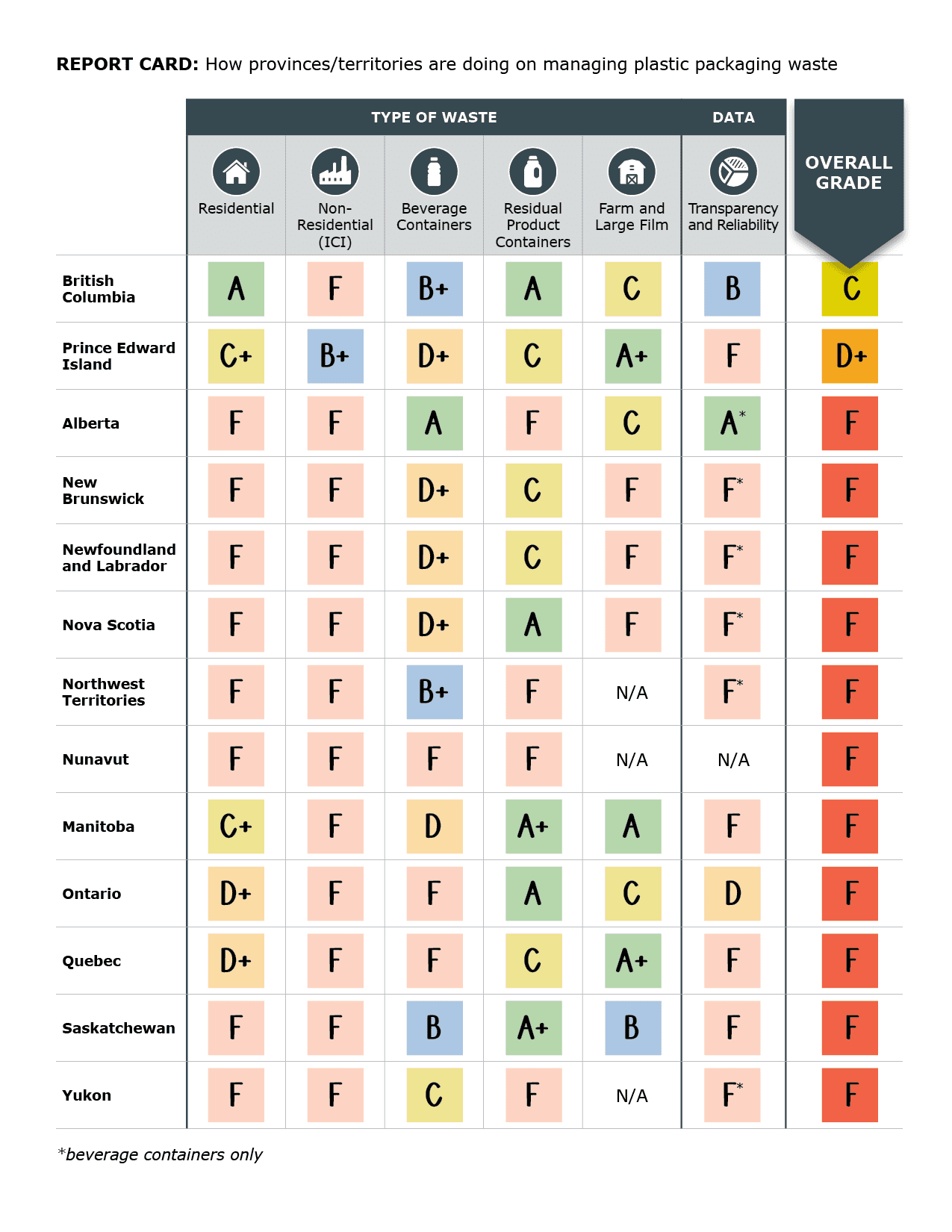Recycling Failure
A report card on provincial performance on plastic waste and the faulty logic behind Canada's plastic pollution strategy
The federal government—recognizing the hazard posed by plastic pollution—has committed to eliminating plastic waste by 2030. Ninety-five per cent of all manufactured products contain plastic, from single-use items like bags and straws, to everyday items like clothing and toothbrushes. Even more durable items like furniture, toys and vehicles are all made with plastic.
But this comes at a cost. Plastic has an environmental impact across its entire lifecycle. It starts right at the beginning with the extraction and processing of fossil fuels to make plastic, which emit greenhouse gasses and other pollutants and destroy habitats. Toxic chemicals are often emitted when those fossil fuels are manufactured into plastic products. Products also shed plastic particles as we use them. Finally, when we throw these items away, 91 per cent end up in landfills, incinerators or our environment. There are devastating impacts when plastic products end up in the environment, including the entanglement, suffocation, starvation and death of wildlife.
This report examines plastic packaging—the biggest single driver of plastic waste and subject to the broadest range of government policies. We find that Canada will continue to dispose up to 2 million tonnes of plastic waste in 2030 if we continue to rely on recycling and largely failing provincial waste systems to eliminate plastic waste.
Canada cannot close the waste gap by 2030 without substantial new action by all levels of government. Even if all provinces and territories level up to the most ambitious systems to manage plastic packaging waste, we will still miss our target.
IF WE STICK TO THE STATUS QUO...
=
EVEN IN THE BEST CASE SCENARIO...
=
*ICI: Industrial, commercial and institutional, *Bottles: Beverage containers

With no improvements to regulation and policy, Canada will dispose more than 2 million tonnes of plastic waste from packaging alone in 2030. This means that 88% of plastic packaging will continue to end up in landfills, incinerators or the natural environment.
But even if all of Canada’s provinces and territories were to level up to the most ambitious waste management systems in Canada, we will still miss our target. In this sad best case scenario, 39% of the plastics packaging generated – nearly 1 million tonnes – will continue to end up in landfills, incinerators or the natural environment.
While the industrial, commercial, and institutional (ICI) sector is the largest contributor to plastic packaging and product waste, Quebec is the only province that plans to require businesses to reduce and recycle their waste by 2030.
Only British Columbia, Québec, and Ontario have plans in place that will be able to measure their recycling systems and determine the amount of material that is collected, sorted, and sent to a re-processor for recycling. Québec is the only jurisdiction that has proposed ‘recycling targets’ that can measure the amount of materials that are actually being used to make new goods in a circular economy (e.g., bottle to bottle recycling). No province or territory has set targets to require reuse of containers.
All provinces and territories must have systems capable of collecting and recycling or reusing all plastic packaging and products by 2030.
Canada is not on track to eliminate plastic waste by 2030. Without more action at all levels of government, up to 2 million tonnes of plastic from packaging will continue to end up in landfills, incinerators, and the natural environment.
For decades, provinces and territories have been attempting to manage plastic waste and pollution, yet the problem has only grown. It’s clear that Canada will not eliminate plastic waste by relying on waste management solutions like recycling—even with improved recycling systems and higher recycling targets.
Recommendations:
Let's take action!
ACKNOWLEDGEMENTS: Produced by ENVIRONMENTAL DEFENCE and JTL SQUARED CONSULTING INC. Full report researched and written by Jodi Tomchyshyn London for Environmental Defence. Webpage written by Karen Wirsig, with contributions by Lauren Thomas, based on Jodi Tomchysyn London’s report.
© Copyright September 2022 by ENVIRONMENTAL DEFENCE CANADA and JTL SQUARED CONSULTING INC. Permission is granted to the public to reproduce or disseminate this report, in part, or in whole, free of charge, in any format or medium without requiring specific permission. Any errors or omissions are the responsibility of ENVIRONMENTAL DEFENCE CANADA.